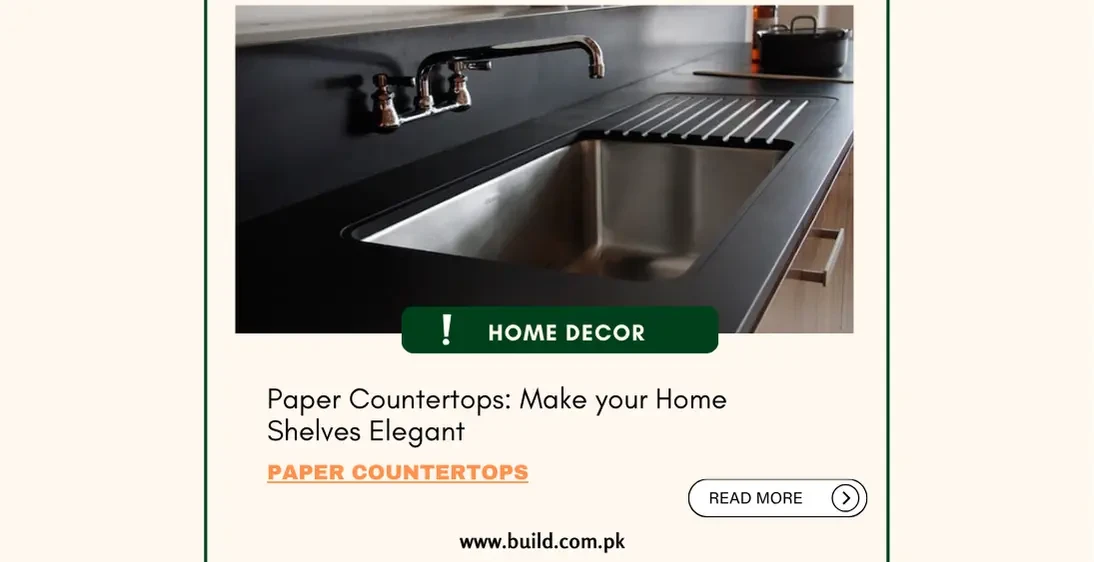Paper Countertops: Make your Home Shelves Elegant

Introduction:
Innovative
and eco-friendly, paper countertops have emerged as a sustainable alternative
to traditional countertop materials like granite, marble, and laminate. Made
from recycled paper and other sustainable components, these countertops offer
durability, versatility, and unique aesthetics. This comprehensive guide delves
into the world of paper countertops, exploring their composition, benefits,
installation process, and maintenance requirements.
Understanding Paper Countertops
Paper countertops are crafted from layers of recycled paper, combined with resins and other binders to create a durable and resilient surface. These countertops mimic the appearance of natural stone, wood, or concrete while offering a more sustainable and cost-effective option.
Composition:
Paper countertops typically cnsist of multiple layers of recycled paper,
sourced from post-consumer waste or sustainably managed forests. The paper
fibers are saturated with resin, such as phenolic or melamine, and compressed
under high pressure to create a solid surface. Pigments and additives can be
introduced to achieve desired colors and textures.
Durability:
Despite their paper-based composition, paper countertops are surprisingly
durable and resistant to scratches, stains, and heat. The resin binder provides
strength and stability, making them suitable for use in kitchens, bathrooms,
and other high-traffic areas. Some manufacturers enhance the durability of
paper countertops by incorporating additional layers of reinforcement or
protective coatings.
Aesthetics:
Paper countertops come in a wide range of colors, patterns, and textures,
offering endless design possibilities. Whether you prefer the look of natural
stone, wood grain, or modern concrete, there's a paper countertop to suit your
style. The versatility of paper countertops allows for customizations such as
embedded objects, decorative inlays, or textured finishes, adding character and
personality to your space.
Benefits of Paper Countertops
Paper countertops offer numerous benefits beyond their sustainable composition. Here are some of the key advantages of choosing paper countertops for your home.
Environmentally Friendly:
Paper countertops are an eco-friendly choice, as they are made from
recycled materials and require minimal energy to manufacture. By diverting
waste paper from landfills and reducing the demand for virgin materials, paper
countertops help to conserve natural resources and reduce environmental impact.
Cost-Effective:
Compared to natural stone countertops like granite or marble, paper countertops
are more affordable, making them an attractive option for budget-conscious
homeowners. Additionally, the installation costs for paper countertops are
generally lower, as they are lighter and easier to work with than solid stone
slabs.
Versatility:
Paper countertops offer versatility in terms of design and customization. They
can be easily cut, shaped, and formed to fit any space or design aesthetic.
With a wide range of colors, patterns, and finishes available, you can achieve
the look of natural stone, wood, or concrete without the hefty price tag.
Low Maintenance:
Paper countertops are relatively low maintenance, requiring only
periodic cleaning with mild soap and water to keep them looking their best.
Unlike porous materials like granite or marble, paper countertops are
non-porous and resistant to moisture, making them less susceptible to staining
or bacterial growth.
Installation Process for Paper Countertops
Installing paper countertops involves several steps, from measuring and cutting the countertops to sealing and finishing the edges. Here's an overview of the installation process.
Measurement and Template Cration:
The installation process begins with accurate measurements of the countertop area. Templates are created using cardboard or other flexible materials to ensure precise cuts and fits.
Cutting and Fabrication:
Once the templates are made, the paper countertops are cut to
size using standard woodworking tools such as saws, routers, and sanders.
Special attention is paid to corners, edges, and cutouts for sinks or
appliances.
Adhesive Application:
The countertops are then bonded to the underlying cabinetry or
support structure using adhesive. The adhesive is applied evenly to the
substrate, and the countertops are carefully positioned and secured in place.
Sealing and Finishing:
Depending on the manufacturer's recommendations, the countertops
may require sealing or finishing to protect against moisture and enhance
durability. Sealants or topcoats are applied to the surface and allowed to dry
completely before use.
Maintenance Tips for Paper Countertops
Proper maintenance is essential to preserve the beauty and integrity of paper countertops. Here are some tips to keep your countertops looking like new.
Regular Cleaning:
Clean your paper countertops regularly with a mild soap and water
solution to remove dirt, grease, and stains. Avoid abrasive cleaners or harsh
chemicals, as they can damage the surface.
Avoid Heat and Sharp Objects:
While paper countertops are heat-resistant to some
extent, it's best to use trivets or hot pads to protect them from direct
contact with hot pots, pans, or appliances. Similarly, avoid cutting directly
on the countertop surface to prevent scratches or gouges.
Wipe Up Spills Promptly:
Promptly wipe up any spills or liquids to prevent staining
or water damage. Although paper countertops are resistant to moisture,
prolonged exposure to standing water can cause warping or delamination.
Use Cutting Boards and Trivets:
To protect the surface of your paper countertops,
always use cutting boards for food preparation and trivets or hot pads for hot
dishes or cookware. This helps prevent scratches, stains, and heat damage.
Conclusion:
Paper
countertops offer a sustainable, cost-effective, and stylish alternative to
traditional countertop materials. With their durable construction, versatile
design options, and eco-friendly composition, paper countertops are an
excellent choice for homeowners looking to enhance their kitchen or bathroom
spaces while minimizing their environmental footprint.
By understanding the composition, benefits, installation process, and maintenance requirements of paper countertops, you can make an informed decision and enjoy the beauty and functionality of these innovative surfaces in your home. Whether you prefer the look of natural stone, wood grain, or modern concrete, paper countertops offer endless possibilities for creating a unique and personalized space that reflects your style and values.









